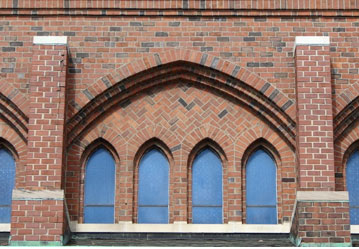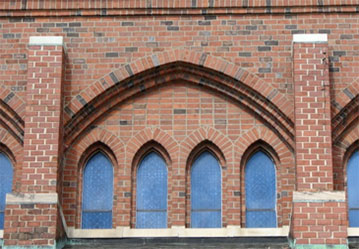45. Redeemer Lutheran, 1915
631 North 19th Street (at West Wisconsin Avenue)
Architects: Schuchardt and Judell

The Reverend Dr. William Frick founded the English Lutheran Church of the Redeemer in 1890, as the city’s first Lutheran church to use the English language exclusively. Although the older congregation of Ascension Lutheran on the South Side supplemented its more common Norwegian services with some in English, all of the other Lutheran churches in the city at that time conducted services in Danish, German, Norwegian, or Swedish. Frick expressed his desire for a more American Lutheran congregation with the slogan, “the faith of the fathers in the language of the children” (Stubbe, page 12). Some of the city’s other Lutheran ministers were initially wary of Frick’s intentions, fearing that he was trying to poach the more assimilated members from their own congregations.
Redeemer Lutheran’s first church, dedicated in December of 1890, was on 16th Street between Wisconsin Avenue and Wells Street. (The church no longer exists, and the property is now part of the Marquette University campus.) Growth over the following two decades led the congregation to acquire its current property for a new and larger church in 1911. After lengthy fundraising efforts, construction of the present church began in 1915, with dedication of the completed building in February of 1917.
The church commissioned the partnership of Schuchardt and Judell to design its new place of worship, with William Schuchardt (1873-1958) acting as the primary designer. Schuchardt was born in Milwaukee and studied architecture at Cornell University, graduating in 1895. He established an office in Milwaukee ten years later, after working for several prominent architects in New York, Philadelphia, and Chicago. Schuchardt partnered with Walter Judell for a brief period, from about 1914 to 1919. As a sole practitioner and in partnership with Judell, Schuchardt designed at least a dozen large houses on Milwaukee’s Upper East Side, in a variety of historical revival styles. Redeemer Lutheran appears to have been his only church commission.
For the congregation of Redeemer Lutheran, Schuchardt designed a church that is distinctive in its simplicity. The exterior is red brick with only a small amount of limestone trim, and lacks the decorative brickwork, elaborate window tracery, pinnacles, or other ornamental features common to the city’s earlier Gothic Revival churches. The only decorative touches are the variations in brick bonding patterns seen in a few locations. The church is also unusual for its size and date in having no bell tower.
The interior is similarly plain and unadorned, with no painted plaster or applied ornament. The exposed brick columns are load-bearing rather than concealing steel columns, and their robust dimensions give a sense of solidity to the church. The leaded glass windows are attached directly to the brick walls without wood or steel frames, keeping to a minimum the number of different materials used on both the interior and exterior.
The church has a basilican plan with no windows in the side aisles. Daylight is provided only by the clerestory windows and the large window above the front entrance. The proportions of the nave are quite tall and narrow compared to many of the city’s other Gothic Revival churches. The nave is 42 feet in width, while the highest point of the ceiling is nearly 52 feet above the floor.
Redeemer Lutheran is one of Milwaukee’s earliest examples of a more academic version of the Gothic Revival that became increasingly popular during the first decades of the twentieth century. In addition to the straightforward use of materials and direct expression of structure, these churches are more closely modeled on the Gothic churches of Europe, although at a reduced scale compared to the Gothic cathedrals.
Alterations to this century-old church have been minimal. The windows originally had clear or lightly-tined glass in diamond patterns. They were replaced by the current pictorial stained glass of predominantly rich blue hues. The original wood doors at the front entrance have been replaced by glass doors in anodized aluminum frames. The church otherwise appears as originally built and stands today as a distinctly twentieth century approach to the use of a historical revival style.
Sources:
“Death Comes to Schuchardt,” Milwaukee Journal, April 18, 1958, page 2, column 1.
Evangelical Lutheran Church of the Redeemer, Fiftieth Anniversary, 1890-1940. Evangelical Lutheran Church of the Redeemer, 1940.
“New Church Will be Dedicated on Sunday,” Milwaukee Sentinel, February 17, 1917, page 7, column 4.
Schuchardt and Judell, architects. Drawings for construction of the Lutheran Church of the Redeemer, dated September 25, 1915. Wisconsin Architectural Archive, Milwaukee Central Library, drawing set 133-2.
Stubbe, Ray William. The Heritage of Those that Fear thy Name. Evangelical Lutheran Church of the Redeemer, 1965.

